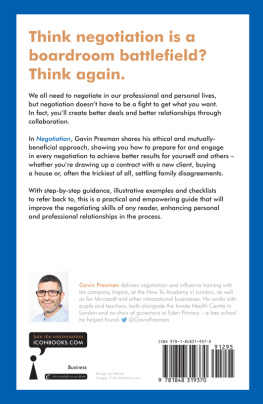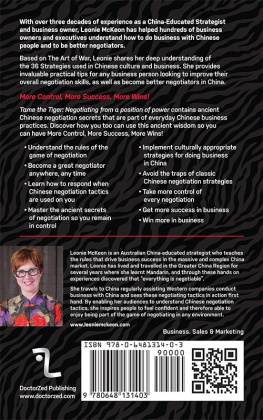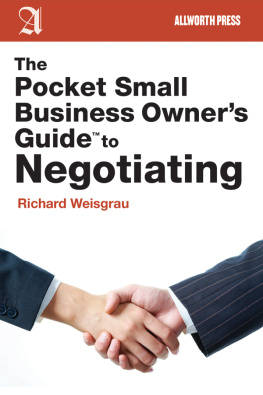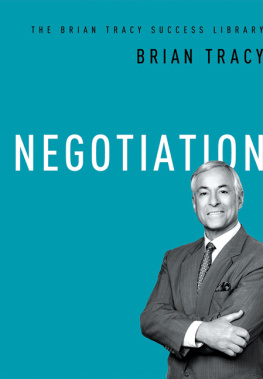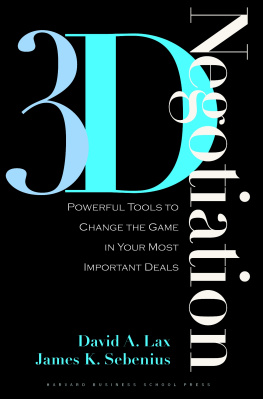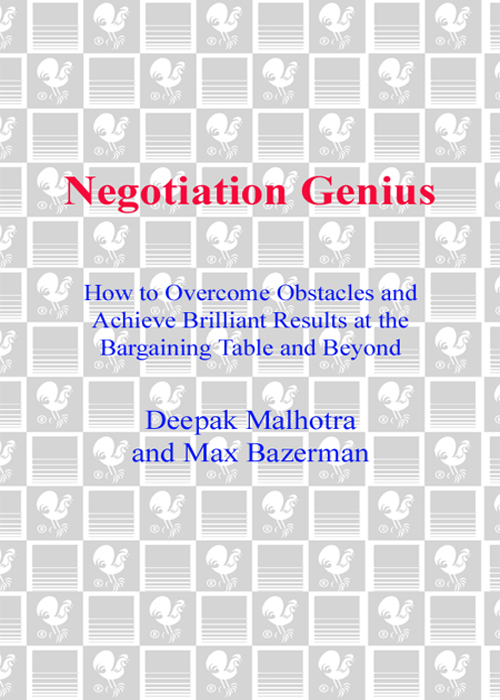
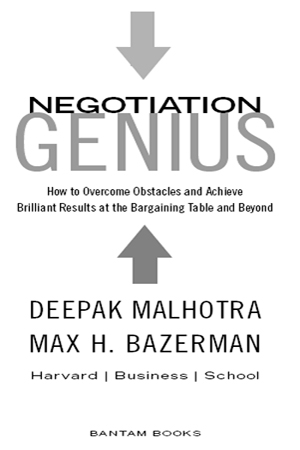
CONTENTS

Dedicated to Shikha and Marla
Your ideas and encouragement influence everything we do.
INTRODUCTION

Becoming a Negotiation Genius
W hat is a negotiation genius? Lets start with the simple observation that you often know a negotiation genius when you see one. You can see genius in the way a person thinks about, prepares for, and executes negotiation strategy. You can see genius in the way a person manages to completely turn around a seemingly hopeless negotiation situation. You can see genius in the way a person manages to negotiate successful dealsconsistentlywhile still maintaining her integrity and strengthening her relationships and her reputation. And, in all likelihood, you know who the negotiation geniuses are in your organization. This book will share with you their secrets.
Consider the following stories, in which negotiators faced great obstacles, only to overcome them to achieve remarkable levels of success. But we will not reveal how they did ityet. Instead, we will revisit these storiesand many others like themin the chapters that follow, as we share with you the strategies and insights you need to negotiate like a genius in all aspects of life.
A FIGHT OVER EXCLUSIVITY
Representatives of a Fortune 500 company had been negotiating the purchase of a new product ingredient from a small European supplier. The parties had agreed to a price of $18 per pound for a million pounds of product per year, but a conflict arose over exclusivity terms. The supplier would not agree to sell the ingredient exclusively to the U.S. firm, and the U.S. firm was unwilling to invest in producing a new product if competitors would have access to one of its key ingredients. This issue appeared to be a deal breaker. The U.S. negotiators were both frustrated and surprised by the small European firms reticence on the issue of exclusivity; they believed their offer was not only fair, but generous. Eventually, they decided to sweeten the deal with guaranteed minimum orders and a willingness to pay more per pound. They were shocked when the European firm still refused to provide exclusivity! As a last resort, the U.S. negotiators decided to call in their resident negotiation genius, Chris, who flew to Europe and quickly got up to speed. In a matter of minutes, Chris was able to structure a deal that both parties immediately accepted. He made no substantive concessions, nor did he threaten the small firm. How did Chris manage to save the day? We will revisit this story in Chapter 3.
A DIPLOMATIC IMPASSE
In the fall of 2000, some members of the U.S. Senate began calling for a U.S. withdrawal from the United Nations. Meanwhile, at the United Nations, the United States was on the verge of losing its vote in the General Assembly. The conflict was over a debt of close to $1.5 billion, which the United States owed to the UN. The United States was unwilling to pay unless the UN agreed to a variety of reforms that it felt were long overdue. Most important, the United States wanted a reduction in its assessmentsthe percentage of the UNs yearly regular budget that the United States was obligated to payfrom 25 percent to 22 percent. The problem was this: if the United States paid less, someone else would have to pay more.
There were other serious complications as well. First, UN regulations stipulated that Richard Holbrooke, U.S. ambassador to the UN, had to convince all 190 countries to ratify the changes demanded by the United States. Second, Holbrooke faced a deadline: if he could not strike a deal before the end of 2000, the money set aside by Congress to pay U.S. dues would disappear from the budget. Third, no nation seemed willing to increase its assessments in order for the United States to get a break. How could Holbrooke convince even one nation to increase its assessment when they all claimed this was impossible? As the end of 2000 approached, Holbrooke decided on a different strategy. He stopped trying to persuade other nations to agree to his demands. What he did instead worked wonders: the issue was resolved, and Holbrooke was congratulated by member states of the UN as well as by members of both political parties in the U.S. Congress. How did Holbrooke resolve this conflict? We will revisit this story in Chapter 2.
A LAST-MINUTE DEMAND
The CEO of a construction company was negotiating a deal in which his firm would be contracted to build midsize office buildings for a buyer. After months of negotiations had finally concludedbut just before the contract was signedthe buyer approached the builder with an entirely new and potentially costly demand. The buyer wanted to include a clause in the contract that would require the builder to pay large penalties if the projects completion was delayed by more than one month. The builder was irritated by this sudden demand; it seemed as though the buyer was trying to squeeze a last-minute concession from him. The builder weighed his options: he could accept the buyers demand and seal the deal; he could reject the buyers demand and hope this would not destroy the deal; or he could try to negotiate to reduce the proposed penalties. After considering these options, the builder decided on an entirely different approach. He negotiated with the buyer to increase the amount of penalties he (the builder) would have to pay if the project was delayedand the revised deal made both parties better off. How? We will revisit this example in Chapter 3.
A CAMPAIGN CATASTROPHE
It was 1912, and former president Theodore Roosevelt was campaigning for a third term. The campaign was tough; every day seemed to present new challenges. But here was a challenge that no one had anticipated. Three million copies of Roosevelts photograph had already been printed for circulation with a campaign speech when Roosevelts campaign manager discovered a catastrophic blunder: the photographer had not been asked permission for the use of Roosevelts photograph. To make matters worse, it was soon discovered that copyright law allowed the photographer to demand as much as $1 per copy to use the photograph. Losing $3 million in 1912 would be equivalent to losing over $60 million today. No campaign could afford that. The alternative was almost equally unattractive; reprinting three million brochures would be tremendously costly and could cause serious delays. The campaign manager would have to try to negotiate a lower price with the photographer, but how? The photographer seemed to hold all the cards. The campaign manager, however, had something better: an effective strategy that he used to negotiate an almost unbelievable deal. We will reveal the dealand the strategyin Chapter 1.
As we hope to persuade you, people are rarely born negotiation geniuses. Rather, what appears to be genius actually reflects careful preparation, an understanding of the conceptual framework of negotiation, insight into how one can avoid the errors and biases that plague even experienced negotiators, and the ability to structure and execute negotiations strategically and systematically. This book will provide you with this frameworkand with an entire toolkit of negotiation strategies and tactics that you can put to work immediately. As you begin to apply the framework and strategies in the many negotiations you encounterin business, in politics, or in everyday lifeyou will begin to build your own reputation as a negotiation genius.
Next page


